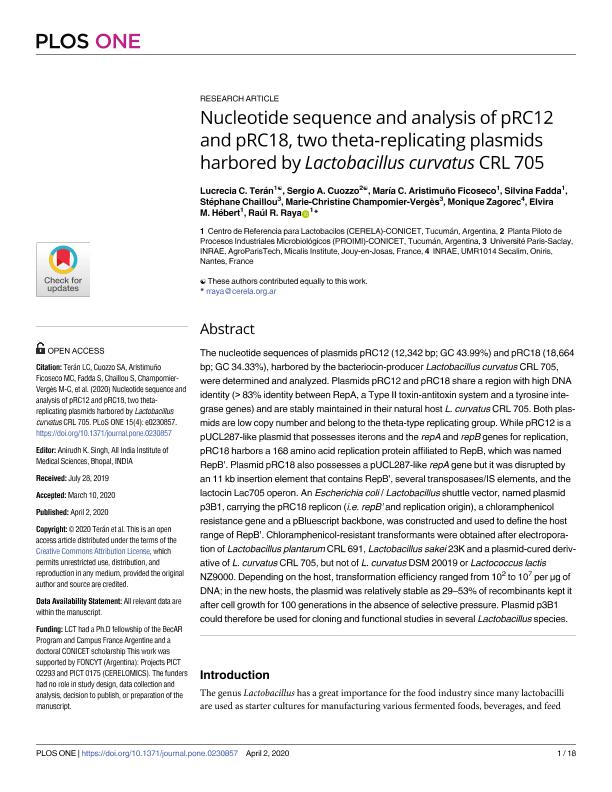Artículo
Nucleotide sequence and analysis of pRC12 and pRC18, two theta-replicating plasmids harbored by Lactobacillus curvatus CRL 705
Teran, Lucrecia Cecilia ; Cuozzo, Sergio Antonio
; Cuozzo, Sergio Antonio ; Aristimuño Ficoseco, Maria Cecilia
; Aristimuño Ficoseco, Maria Cecilia ; Fadda, Silvina G.
; Fadda, Silvina G. ; Chaillou, Stéphane; Champomier Vergès, Marie Christine; Zagorec, Monique; Hebert, Elvira Maria
; Chaillou, Stéphane; Champomier Vergès, Marie Christine; Zagorec, Monique; Hebert, Elvira Maria ; Raya, Raul Ricardo
; Raya, Raul Ricardo
 ; Cuozzo, Sergio Antonio
; Cuozzo, Sergio Antonio ; Aristimuño Ficoseco, Maria Cecilia
; Aristimuño Ficoseco, Maria Cecilia ; Fadda, Silvina G.
; Fadda, Silvina G. ; Chaillou, Stéphane; Champomier Vergès, Marie Christine; Zagorec, Monique; Hebert, Elvira Maria
; Chaillou, Stéphane; Champomier Vergès, Marie Christine; Zagorec, Monique; Hebert, Elvira Maria ; Raya, Raul Ricardo
; Raya, Raul Ricardo
Fecha de publicación:
02/04/2020
Editorial:
Public Library of Science
Revista:
Plos One
ISSN:
1932-6203
Idioma:
Inglés
Tipo de recurso:
Artículo publicado
Clasificación temática:
Resumen
The nucleotide sequences of plasmids pRC12 (12,342 bp; GC 43.99%) and pRC18 (18,664 bp; GC 34.33%), harbored by the bacteriocin-producer Lactobacillus curvatus CRL 705, were determined and analyzed. Plasmids pRC12 and pRC18 share a region with high DNA identity (> 83% identity between RepA, a Type II toxin-antitoxin system and a tyrosine integrase genes) and are stably maintained in their natural host L. curvatus CRL 705. Both plasmids are low copy number and belong to the theta-type replicating group. While pRC12 is a pUCL287-like plasmid that possesses iterons and the repA and repB genes for replication, pRC18 harbors a 168 amino acid replication protein affiliated to RepB, which was named RepB’. Plasmid pRC18 also possesses a pUCL287-like repA gene but it was disrupted by an 11 kb insertion element that contains RepB’, several transposases/IS elements, and the lactocin Lac705 operon. An Escherichia coli / Lactobacillus shuttle vector, named plasmid p3B1, carrying the pRC18 replicon (i.e. repB’ and replication origin), a chloramphenicol resistance gene and a pBluescript backbone, was constructed and used to define the host range of RepB’. Chloramphenicol-resistant transformants were obtained after electroporation of Lactobacillus plantarum CRL 691, Lactobacillus sakei 23K and a plasmid-cured derivative of L. curvatus CRL 705, but not of L. curvatus DSM 20019 or Lactococcus lactis NZ9000. Depending on the host, transformation efficiency ranged from 102 to 107 per μg of DNA; in the new hosts, the plasmid was relatively stable as 29–53% of recombinants kept it after cell growth for 100 generations in the absence of selective pressure. Plasmid p3B1 could therefore be used for cloning and functional studies in several Lactobacillus species.
Palabras clave:
PLASMIDS
,
LACTIC ACID BACTERIA
,
REPLICATION
Archivos asociados
Licencia
Identificadores
Colecciones
Articulos(CERELA)
Articulos de CENTRO DE REFERENCIA PARA LACTOBACILOS (I)
Articulos de CENTRO DE REFERENCIA PARA LACTOBACILOS (I)
Citación
Teran, Lucrecia Cecilia; Cuozzo, Sergio Antonio; Aristimuño Ficoseco, Maria Cecilia; Fadda, Silvina G.; Chaillou, Stéphane; et al.; Nucleotide sequence and analysis of pRC12 and pRC18, two theta-replicating plasmids harbored by Lactobacillus curvatus CRL 705; Public Library of Science; Plos One; 15; 4; 2-4-2020; 1-18;e0230857-e0230857
Compartir
Altmétricas



